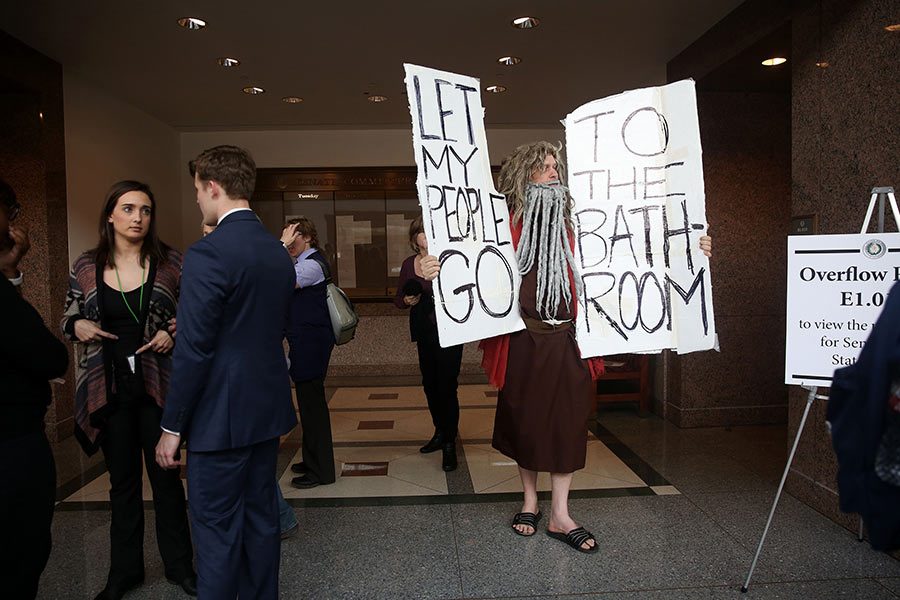Texas bathroom ordinance renewed
Texas passes new “bathroom bill” that would forbid students from using bathroom of gender identity
John Erler, dressed as Moses, holds signs as members of the Senate State Affairs Committee debate and hear public testimony over Senate Bill 6, the transgender bathroom bill, on Tuesday, March 7, 2017 at the Texas State Capitol in Austin, Texas. The bill would require transgender Texans to use public restroom facilities that match their birth gender. (Rose Baca/Dallas Morning News/TNS)
May 23, 2017
On Sunday, the Texas House of Representatives voted regarding a controversial “bathroom bill.” This legislation was approved with a vote 91-50 and will prohibit transgender students in public schools from using the restroom that matches their gender identity.
The bill was put on fast track as Lt. Governor Dan Patrick threatened to put the state budget on hold if the bill was not approved before the session closes on May 29.
“I think this legislation protects the trans students who would have gone to a different restroom because, especially in a public high school with young adults, it could lead to more bullying that could happen in the restroom,” Principal Brad Bailey said. “We want to be an inclusive environment at Texas High, but we also have to follow the policy and the law and that’s what we will do.”
Texas High will be relatively unaffected with the passage of the bill considering the fact that the school’s policies are already in compliance with the proposed bill.
“At our school, transgender students are required to use the restroom of their biological sex, so if they have male anatomy or female anatomy that is the restroom they would use,” Bailey said. “We have to support [transgender students] and provide them with counseling and the confidence that we are here to help them. We are not here to discriminate against anyone.”
This policy is put in place to try and avoid as many potential conflicts as possible.
“To my knowledge, I don’t think we’ve had any issues of anyone using a different bathroom. Obviously if something was reported then we would address it,” Bailey said. “If someone comes to me and is uncomfortable then we will work through that situation.”
In 2016, a federal mandate was issued in an attempt to allow transgender students to use bathrooms they identified with. As the recent bill reverses last year’s efforts, there is a pervasive feeling of anxiety in the LGBTQ community.
“People read too much into it and over sexualize things that should not be over sexualized: our gender and us going to the bathroom,” freshman Atlas Hines, a transgender male, said. “I feel like people should be able to go to the bathroom where they feel most comfortable.”
However, while schools would ideally like for everyone to feel comfortable using the bathrooms, the reality of the situation proves to be a difficult task to meet as politics surround the controversy. The school’s responsibility to protect both the transgender students and other students in the restroom at the same time proves difficult. If implemented into schools, it is challenged on the basis of undermining trans students’ basic civil rights.
“White. Colored. I was living through that era … bathrooms divided us then, and [they] divide us now,” Democratic state Rep. Senfronia Thompson of Houston said. “America has long recognized that separate but equal is not equal at all.”
With this in mind, it is brought into question whether or not the bill will do more good than it does harm, and it is something that will be left unknown until future conflicts arise and are dealt with.
“We probably have more students who would identify as transgender, but they fear the negative feedback and the backlash,” English Department Head Monica Washington said. “Students may feel like they are suffering, but they can’t say anything about it because it isn’t seen as a legitimate problem. I know it isn’t the same thing as race, but the fight has been similar in some ways. People fought to decide who would be able to use certain water fountains. Back then, they believed that was wrong and we may be at one of those moments again and we just don’t realize it.”
This idea of suffering in silence is something that Hines has grown accustomed to in order to try and comply with the school’s current bathroom policy.
“I don’t use the bathroom here because I don’t want to feel uncomfortable,” Hines said. “I don’t want every time I go to the bathroom to be a political decision. I don’t think I’m being offered the same chances as everyone else. I can see both sides how it would be an issue, here at least, but I still don’t feel equal.”
The question of how to ensure that every student feels equal is something that must be addressed as the school moves forward in the future.
“There needs to be education for students that aren’t transgender, who are transgender and for staff to identify things in classrooms that are inappropriate,” Washington said. “Equity has to be broader. We have gay students, bi students, straight students, trans students, white students, black students, boys and girls; a larger group of people who all need equity. In the past years, the U.S. education system has had a very narrow view of what equity is. There needs to be training to ensure that these students are comfortable.”
Going forward from here, the main priority is to ensure the safety of students while being compliant with laws that may be enforced in order to try to uphold the ideal of “no child left behind.”
“We want to protect the person, we want to protect the student, and above all, we want to put students first. Whatever we can do to help support them and give them advocacy, that is what we will do,” Bailey said. “Obviously we will follow the law that has been put into place, but we want to make sure they are supported and whatever needs that they have we will do whatever is in our scope to meet those needs.”

















